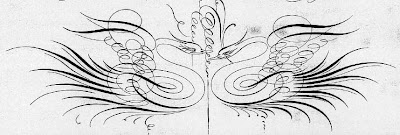World championship yo-yo tricks.
Radio control helicopter aerobatics.
In the art of penmanship, the ultimate showcase of skill is called offhand flourishing. This combination of drawing and calligraphy was a natural outgrowth of decorations in pointed pen lettering. It was created at one shot without much in the way of preliminary drawing, which is where we get the figurative sense of the word “offhand.”

(Click to enlarge the picture above, which is from an 1880 penmanship manual called “Real Penwork Compendium of Penmanship.”)

It may not look like anything more than squiggly doodles to the uninitiated, but pictures made from flourishes are incredible difficult. It takes deep practice, good breathing, perfect posture, and a clear mind.
Here’s how master penman W.E. Dennis, in his 1914 book Studies in Pen Art, describes the challenge:
“It is doubtful if anything in penwork requires more real skill, sureness of stroke, delicacy of touch and absolute freedom of arm and hand than Off-hand Flourishing. Certainly none of the other work in this book offers the technical difficulties found in the flourished designs, the most difficult of all being the two swans facing each other. Lettering is more or less mechanical, but flourishing is quite the opposite. In this work the mind must conceive quickly the arrangement of harmonious, well-balanced curves, and the hand must reproduce them without hesitation. In addition to this, the penman should have in mind some harmonious design, pleasing in effect as a whole.”--------
Studies in Pen Art, by W.E. Dennis, available as a free PDF download.
Collection of free PDFs from IAMPETH (International Association of Master Penmen, Engrossers, and Teachers of Handwriting)







6 comments:
Incredible; I can only imagine how difficult this must be. I'm certainly not going to attempt it...
Maybe when I'm feeling a bit too sure of myself.
James,
The book 'the brain that changes itself' - about neuroplasticity- had a study that showed that boys with ADD who practiced learning a foreign script (like say urdu) and memorizing long poems showed more improvement in 'curing' ADD than ADD drugs. The book also mentioned that penmanship and rote learning long poems used to be a large part of grade school curriculum, jettisoned, like so much else, in the 1960s.
BTW, I was at the norman rockwell exhibit in Brooklyn today, and noticed a James Gurney' is lending a rockwell piece from his collection. You? if so, as a museum goer, i thank you!
...Yes...'My pen Name' is right .... when I was in grade school they through out penmanship practice (cursive).
They tried teaching us some dumb way of writing, learning english, grammar etc. A whole new alphabet so to speak, all printing, where vowels and consonants were connected and words were written phonetically...We were their guinea pigs in a failed experiment.
To this day I, and one of my sisters who went through at the same time, have the worst and ugliest handwriting simply because it was not practiced in our formative years.
I have tried to 'fix it' over the years by practicing, get to a point where my penmanship improves then ultimately it reverts back.
It is a bit like kids who never play sports, get outside and run, get physical in their play, then as adults they never have the same athletic (motor) skills and co-ordination as those who did.
Why can't school policy makers accept that certain skills are fundamental to our development as humans and quite trying 'alter the recipe'.
BTW... I still have two of the books from then and they are a riot to look at now.
here's an amazing video that relates (in my opinion) Shaun Tan's work is so amazing and when i heard about a stage version of The Arrival I was immediately skeptical, but check it out! Really amazing design, dancing and acting!
http://www.youtube.com/watch?v=GpoKXTqQYjg&feature=player_embedded
We have offhand flourishing classes at the shop. It isn't easy to find classes in this art, but we have classes and anyone can come and give it a try. It isn't hard to do... but it is nearly impossible to master.
Best wishes!!
I did a lot of study and did study of the form and relationship to the main structure. I learned a lot in that and am able to go back to memory and gain guidance on where I go next with my flourish. I do a lot of practise and try to mimic strokes that are harder for me after doing drills, I am still doing before I start to create something. About 5 minutes of drills gets everything ready to create a finished piece of work. I try and get inspiration from historical works and try to mimic them and all you can do is get the form correct and practice as much as you can each stroke until it becomes second nature. I work on form so I might take a day of practice of bird heads and angles or wings. Break it down into its parts and it will be much easier to master when it comes time for you to come up with your own work. It can be mastered but much practice has to be put into it. You can not expect to have this as a quick "a,b,c" write by numbers art lesson. It is something you must to much time into it to have a good outcome but there is no reason why someone would not be great or an unfound master with some hard work. I in no way claim to be some master myself as I am always learning and working to get better, there is always room for improvement.
Kenneth Keeton
Post a Comment